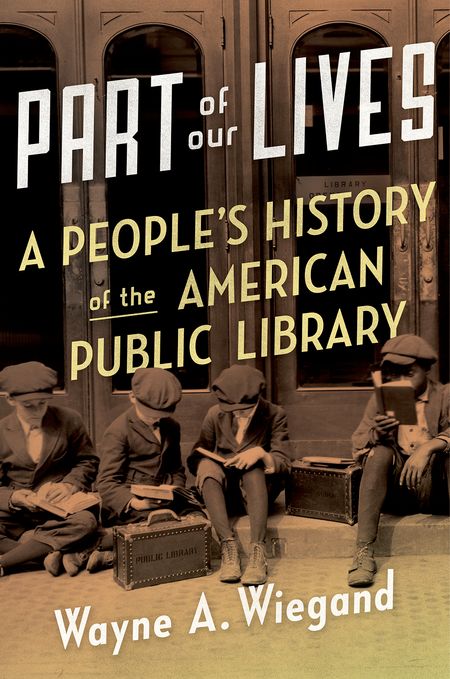In the late nineteenth century, “best reading” gradually replaced “useful knowledge” in the profession’s lexicon, and many patrons continued to use the public library for the best reading it held. In 1884, for example, twenty-four-year-old Hamlin Garland moved from Iowa to Boston to become a writer. Almost immediately he went to the Boston Public Library. There he “read both day and night, grappling with . . . all the mighty masters of evolution.” Bates Hall “was deliciously comfortable,” he remembered. “I had moments of tremendous expansion, hours where my mind went out over the earth like a freed eagle.” Garland was not unlike other “serious” Boston Public Library readers, including Henry Wadsworth Longfellow, Oliver Wendell Holmes, and Mark Twain, who used the library regularly. On the West Coast a teenage wharf rat named Jack London started visiting the Oakland (California) Public Library, where he discovered a world beyond the wharves. For him the library became a refuge, and the librarian—poet Ina Coolbrith—a mentor who took an interest in the waif and became the first person to praise his reading choices.
Disagreements among expert communities about serious reading and useful knowledge sometimes made public libraries a target; in the late nineteenth century, religion was often the cause. Cincinnati’s Catholic Telegraph argued in 1881 that “the number of Catholic books in our Public Library is altogether out of proportion to the number of Catholics paying taxes in this city.” When colleagues refused to subscribe to three Catholic periodicals he recommended in 1879, one Chicago Public Library trustee claimed Catholic information needs were not being fairly addressed. That initiated a flurry of counterclaims. A Tribune editorial asked: “When was [this trustee] appointed . . . as a representative of the ‘Catholic thought’ of this city?” A journalist surveyed newspaper and periodical subscriptions and found that while Catholics comprised 10 percent of Chicago’s population, CPL subscribed to twenty-two Catholic serials compared to six representing other denominations. Although Baptists and Methodists were the city’s two largest denominations, none of their major magazines were represented in the periodical collection. Irish Protestants also complained that the library subscribed to no newspaper representing their interests. These disputes had impact, as was evident at the next board meeting, when the trustees approved subscriptions to the Illustrated Catholic American, the Irishman, and the Celtic Monthly.
While librarians loved to cite successful library patrons who engaged in serious reading, they still had to deal with popular fiction, which nationwide continued to account for 65 to 75 percent of public library circulation. Periodical and newspaper editors often wrote hyperbolic monologues proclaiming that novel reading was evil and that public libraries had no business supplying novels at taxpayer expense. “Think of the condition of these children’s minds at the end of such a carnival of sensations!” marveled the New Hampshire Sentinel when it reported in 1879 that one boy withdrew 102 novels from the Hartford (Connecticut) Public Library in six months, one girl 112 during that same period. Without supplying any evidence, the editor then declared: “It is clear that the provision of so much mental excitement for our young people is doing them great damage.”
Some librarians echoed these concerns. The mind of the novel-reading factory girl, a Germantown (Pennsylvania) librarian said in 1877, “is filled with false ideas of life, and she is prepared easily to be beguiled into an improper marriage, or become the victim of some pretentious scoundrel.” For the boy, he “reads of equally false deeds of daring . . . A dashing life on the frontier, or one of adventure in distant countries is, to his mind, rather to be sought than patient industry in the lot in which Providence has placed him.” Because small-town public libraries seemed less concerned about series fiction than larger urban public libraries, one urban library trustee fussed: “it is to be hoped that the directors of our smaller libraries will gradually attain conceptions of public duty which will prevent them from courting a temporary popularity by hastening to supply immature and unregulated minds with the feverish excitements they have learned to crave.”
Despite librarians’ opposition, however, demand for commonplace reading persisted. In 1879, Boston public librarians counted call slips for books checked out one Saturday; 90 percent were for fiction—the vast majority by authors like Alger, Southworth, and Optic. A year later the trustees reduced the supply of popular fiction by replicating the experiment tried twenty years earlier, with the same results. Circulation rates dropped precipitously. In Milwaukee, fiction accounted for 70 percent of circulation. Titles like The Bridal Eve, The Discarded Husband, and My Little Love, the Milwaukee Sentinel reported, were read over and over, mostly by young and middle-aged women.
Late-nineteenth-century competition in the world of print was keen. One expert estimated that circulation of true crime tabloids in the nation’s barbershops and saloons exceeded 200,000 weekly. In San Francisco, a Californian and Overland Monthly reporter wrote in 1882 that this “pen-poison” literature “makes boys hate work and despise truth and dishonor purity.” Readers, he said, fell into four categories—schoolchildren; factory and shop girls; men who tended bar, drove carriages, and worked on farms and boats; and finally, “fallen women, and, in general, the denizens of the midnight world, night-owls, prowlers, and those who live upon sin and its wages.” That same year a Cincinnati Daily Gazette reporter noted that the Queen City had 175 newsstands that weekly sold 10,000 story papers. The city’s school superintendent had decided opinions about (but offered no evidence for) what happened to children who read this stuff: “Generally, they are poisoned intellectually.” Unfortunately, the public library was well stocked with series fiction, he told the reporter. “A father once remarked to me that he would like to see the Public Library burnt to the ground, as it was ruining his son.” When the Cincinnati Public Library curtailed popular fiction in 1876 and the librarian boasted “a change in the character of the people who use the library,” the Gazette shot back: “Shall the Librarian pronounce it gratifying progress that the poor have ceased to use the library . . . even if they are unattractive in dress and unrefined in manners?”
To those who objected to Alger, Optic, Southworth, and Holmes, the Boston Daily Advertiser responded that library trustees were “justified in providing the kind of reading which is sought for by a large class; gives them pleasure; does them at least no harm; and, being suited to them, brings them a certain amount of intellectual profit and a kind of moral instruction; and, finally, attracts them to the library, where there is a chance that something better may get hold of them.” Social activist Thomas Wentworth Higginson agreed, albeit within the context of white racial pride that series fiction reinforced. What sends a boy to Optic, he contended, “is just that love of adventure which has made the Anglo-American race spread itself across the continent.”
In 1881 the nation witnessed a national debate on public library circulation of fiction. The spark igniting the firestorm was a series of late-1880 Boston Sunday Herald articles written by longtime BPL cataloger James M. Hubbard, which castigated the Boston Public Library for circulating series fiction to children. Hubbard followed these articles with another in the International Review, published a month after he sent the BPL board a list of 100 offending titles. He also petitioned the city council to make BPL collecting practices once again reflect the intentions of the library’s founders. In the Review article Hubbard wrote: “I do not believe it is the proper business for the city to furnish amusing literature to the people free of expense.” Public libraries across the country, he lamented, furnish “this literature in quantities almost unlimited; and they furnish it mainly . . . to the school-children” who ought not be exposed to stories that “instill pernicious doctrines . . . subversive of sound morals.” He called for “a rigid censorship over all works of this class.” The Boston Public Library could easily practice this censorship, he argued, and by example influence other libraries to acquire only the best books.
The Boston Common Council held hearings on Hubbard’s petition in early 1881. Using words like “vulgar,” “immoral,” “nauseous,” and “reeking with sin,” Hubbard castigated sensationalist authors at the hearings and demanded that the fiction and juvenile departments of the library that circulated these authors be closed. Library trustees countered that it would be impossible and improper to exclude authors read by millions of Americans and demanded by BPL readers. However, when Hubbard issued a pamphlet in late 1881 that listed offending titles (including several authored by what he called a “base herd of female novelists”), trustees caved. In January 1882, they removed the books Hubbard listed from circulation, promised to examine them all, to condemn those judged unsuitable, and to return those deemed unobjectionable to BPL shelves.
Elsewhere, newspapers and periodicals joined the debate. A “theory has gained currency among librarians that constant reading of any kind will develop an improvement of taste,” the Cincinnati Daily Gazette noted. “We doubt its truth.” The Boston Public Library had become an institution, The Friend contended, “which was multiplying enormously the very evil which its projector had designed to lessen.” With all the “trash that vitiates the taste and degrades the feelings” that public libraries circulated, an Overland Monthly and Out West Magazine author noted, “it is certainly time that the influential men of every community . . . should insist on a strict and intelligent censorship.” It might be “wiser to spend the public money on free beer than on wretched fiction,” she quipped. The Worcester Daily Spy disagreed. Hubbard’s assumption that public money should not be spent on “pleasure” novels “is not sound,” the Spy said. “Pleasure in itself is not only not ignoble, but it is certainly one, and not the least among the objects of existence.” The Northern Christian Advocate thought some kind of censorship was required, but said it had to come from parents. The Critic simply decried Hubbard’s attempts to craft “an Index Expurgatorius.”
In Chicago, an Inter Ocean reporter used Hubbard’s petition to query library officials. Chicago Public Library Director William Frederick Poole defended the acquisition of authors like Ouida, Holmes, and Southworth. “If every class is taxed for their support, every class should have its choice of books to read.” To the question of whether these novels give “false ideas of life” he responded: “Any of these books are better teachers than the general conversation of the people they meet with in their daily life.” The reporter also interviewed library trustees. One said public libraries should not acquire novels by authors like Southworth. Another agreed, but complained that he was consistently overruled by his colleagues. On the other hand, another trustee said he had met Southworth, and from her conversation he judged her incapable of writing anything damaging to the morals of a sensitive person. The board president noted that because the library could not compel attendance it had to furnish patrons with books they wanted. The city’s school superintendent, an ex-officio board member, agreed. If people could not get series fiction at the library, he insisted, they would obtain worse reading material at local newsstands.
In the midst of this controversy, the American Library Association’s Cooperation Committee surveyed seventy public libraries to see whether their collections included the works of Southworth, Holmes, Alger, Optic, and Ouida. Among the thirty respondents, eleven refused to buy Southworth novels, three had removed Alger and Holmes from their shelves, and two had removed Optic. On the other hand, twenty-four had Alger, twenty-three Holmes, twenty-two Optic, and thirteen Southworth. Except for some agreement on female authors, the survey showed little consensus. Each library, it appears, found an acceptable center of literary values for its community. Whatever their personal objections, librarians, within limits, collected what people wanted and demanded.
In early 1882, a BPL Board Examining Committee issued a report that recommended removal of most of the authors Hubbard had cited in his 1881 pamphlet to what became known as the “Inferno,” a designated place librarians used to sequester certain books. To check out a book in the Inferno—identified with three stars in the card catalog—a patron had to fill out a slip giving age and occupation, a character reference, and reason for requesting the book. “This slip must receive the endorsement of the librarian before the request is complied with,” the rule stated. About the Inferno one Bostonian wondered: “Is there a microscope of sufficient power to detect this grand inquisitorial expurgatorious [sic] of the library?” The Inferno met with mixed reactions across the country. The Congregationalist called it indefensible, because even with this procedure “the library would be bound to furnish free-love publications if enough people called for them!” “The committee’s task is a delicate and difficult one,” the Cincinnati Daily Gazette noted, but “the community cannot be treated as if it were composed wholly of children.”
Although the Boston Public Library’s definition of “immoral” and “objectionable” books shifted because of public pressure brought by Hubbard’s attack, the Inferno provided a solution to a perpetual problem—what to do with titles some thought their community should have in its public library, while others did not. The Inferno helped librarians mediate these disputes in ways ultimately acceptable to both sides, and over the years not only did the Inferno become a place for series fiction that authorities questioned, but it also became a convenient place to park high culture titles whose value was still being debated by literary experts. For example, by 1882 the library relegated to the Inferno not only Ouida, Southworth, and Horatio Alger, but also Walt Whitman’s Leaves of Grass, Boccacio’s Decameron, and all of Emile Zola’s works.
From PART OF OUR LIVES: A People’s History of the American Public Library. Used with permission of Oxford University Press, Inc. Copyright © 2015 by Oxford University Press.













